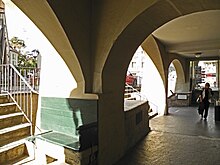Junkerngasse


The Junkerngasse forms part of the UNESCO -protected old town of Bern and is considered the best preserved part.
location
Junkergasse is located in the lower old town. It branches off from Gerechtigkeitsgasse at the Nydeggbrücke and then runs parallel to it. In the west, at the confluence with Kreuzgasse, it is continued by Münstergasse. The narrow lane on the ground floor mostly only has gates and doors on the north side, originally mainly stables and servants' apartments.
history
The Junkerngasse was called Kilchgasse until the 16th century, later Edle Gasse, before it was given its current name in the 17th century. During the time of the French occupation by Napoleon 1798–1803, the street was called Rue des Gentils Hommes . The wealthy Bernese patricians built their city apartments on the south side of the Aare slope. The most beautiful examples are the Béatrice-von-Wattenwyl-Haus and the Erlacherhof , in the north-west corner of which the Junkerngassbrunnen is located opposite the Bubenbergrain. Before the Nydeggbrücke was built in 1844, Junkerengasse merged with Nydeggstalden with a steady gradient. This also explains the deepened arbor at Junkerngasse No. 1. During the construction of the Nydegg Bridge several large buildings had to give way at the lower end, one was rebuilt free-standing at Papiermühlestrasse 9.
In the early morning of January 30, 1997, a fire broke out at Junkerngasse 41. The fire spread within a very short time and destroyed large parts of the houses at Junkerngasse 35–43. The attics of the houses at Junkerngasse 37–41 burned down completely. On all other floors, the extinguishing water, around 250,000 liters per house, caused major damage.
Junkergasse has repeatedly served as a film set: In 1942, Franz Schnyder shot the film Das Gespensterhaus , which was set in Junkerngasse 54, and in 1970 Kurt Früh shot scenes for Dällebach Kari in Junkerngasse.
literature
- Paul Hofer : The art monuments of the canton of Bern . The city of Bern - social houses and residential buildings. Ed .: Society for Swiss Art History (= Die Kunstdenkmäler der Schweiz . Volume 40 ). tape 2 . Birkhäuser Verlag , Basel 1959, The residential buildings II. First Zähringerstadt Junkerngasse, p. 110 , pp. 116–225 (495 pp., Unibe.ch [PDF; 65.0 MB ; accessed on February 10, 2018] History and development of Junkerngasse.).
Web links
Individual evidence
- ^ Zita Caviezel, Georges Herzog, Jürg A. Keller: Basel-Landschaft, Basel-Stadt, Bern, Solothurn (= art guide through Switzerland. Vol. 3). Completely revised edition, 1st edition. Society for Swiss Art History GSK, Bern 2006, ISBN 3-906131-97-1 , p. 170.
- ↑ Reproduction of a painting: Papiermühlestrasse 9; Breitenrain, 19th century. Bern burger library.
- ↑ Böhlenhaus in the Historical-Topographical Lexicon of the City of Bern: "Papiermühlestrasse 9. The house, built around 1700, was originally on Wendschatzgasse. In 1844, master miller Jakob Böhlen acquired the building, which was originally called Jenner House, later called de Rougemont House, had it demolished and rebuilt on his property towards the city of Böhlenstock. Original location: North of the house at Nydeggasse 17. "
- ^ The reconstruction of the house at Junkerngasse 39 in Bern after the fire of January 30, 1997. André Born, Architect (PDF).
- ↑ Lucia Probst: A visit to the "Ghost House" on Junkerngasse. In: bernerzeitung.ch . tamedia , December 23, 2010, accessed October 10, 2012 .
Coordinates: 46 ° 56 '52.2 " N , 7 ° 27' 15.8" E ; CH1903: 601,200 / one hundred and ninety-nine thousand six hundred thirty-nine
